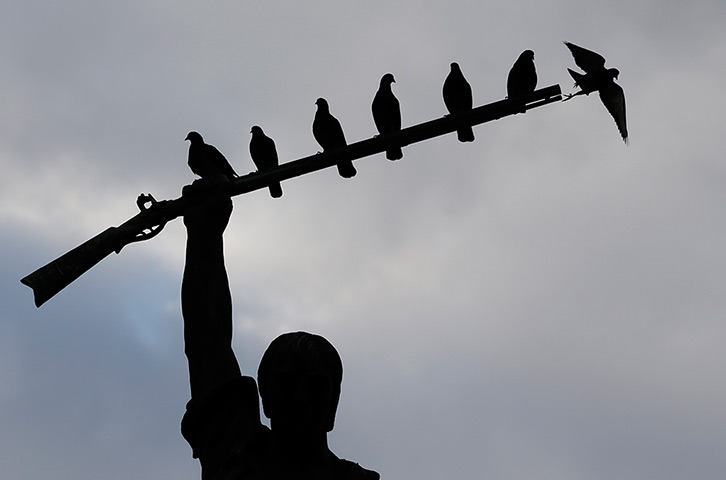Statues of civic heroes are not placed in the town square to become splattered with bird shit, but that is what happens. In fact, birds pay attention to the monuments long after human attention has faded. Once the work has become part of the background of daily life–not to mention an antique artform–it takes a second act of dedicated looking to capture the initial sense of monumentality. And even then, the birds can alter the visual effect.
You might say they’ve become part of the picture. (You can see another example here.) What’s remarkable about this photograph is how it captures simultaneously both the original intention of the art work and its mildly comic appropriation by the birds. Indeed, it blends intention and use in interesting ways. The defiant gesture is beautifully highlighted by the contrast between the dark silhouette and blue and grey sky, while the bird’s behavior also makes perfect sense, not least as they are spaced evenly almost as though part of the original design.
This blending of different perspectives (gun or perch) is reflected symbolically as well. On the one hand, the doves could seem to be an implicit criticism of the martial citizenship that has been set in stone. Instead of the Sturm und Drang of history, they seem to have admirably simple concerns. Instead of battling for sovereignty, they represent another kind of liberty. Instead of trying to make a statement in stone, they alight and fly away as they please. And at the end of the day, it seems that war is trumped by peace.
On the other hand, that bird on the end almost seems to be shot from the gun, and one could say that war buys peace and liberty. This monument in San Antonio to Benjamin Milam celebrates the Texan war of independence, and that political act might acquire the aura of natural law once it is seen as so easily coordinate with a cloudy sky, the symbol of peace, and an act of soaring into space. If you don’t think so, just consider how opinions differ on gun laws. The fact that this image appeared in a slide show during a time of renewed debate about those laws may not be entirely coincidental, and it may well capture a basic dilemma at the heart of that controversy.
Public arts can be used in more than one way. Birds use the statue in ways not intended, and humans do the same. More to the point, the artwork never has only one meaning, even at the moment of dedication. No design can compel only one response, and the meanings vary because viewers vary. The passage of time works in more than one way as well: the public artifact becomes increasingly part of the background, seen but not seen, while the society’s range of possible responses becomes ever larger and more complex.
Photography is a public art, and it records other artworks. Thus, it is subject to all the problems that come with being placed in the public square, but it also can reactivate awareness of what can be seen and how we see in civic spaces. I hate the word “repurposing,” but it captures exactly what has become a common habit of a media-intensive society. Images and other fragments of public culture are continually being put to additional use that may go far beyond what was originally intended. So it is that the image above need not be about the birds or the stature, but about what it means to look at a photograph.
Photograph by Eric Gay/Associated Press.

To add one more layer of meaning: this photo could also refer to the role of Twitter & social media in modern revolutions.
!